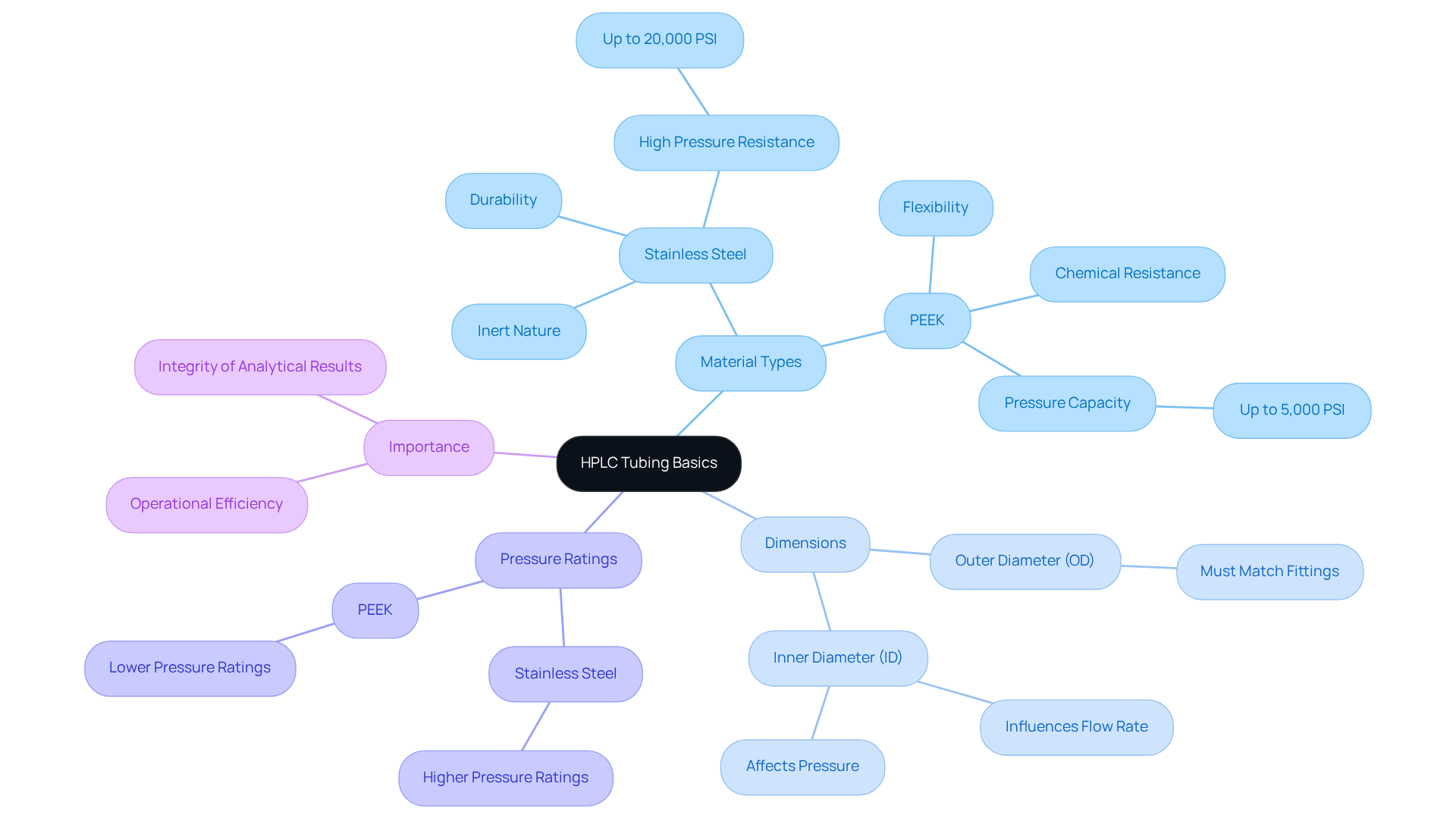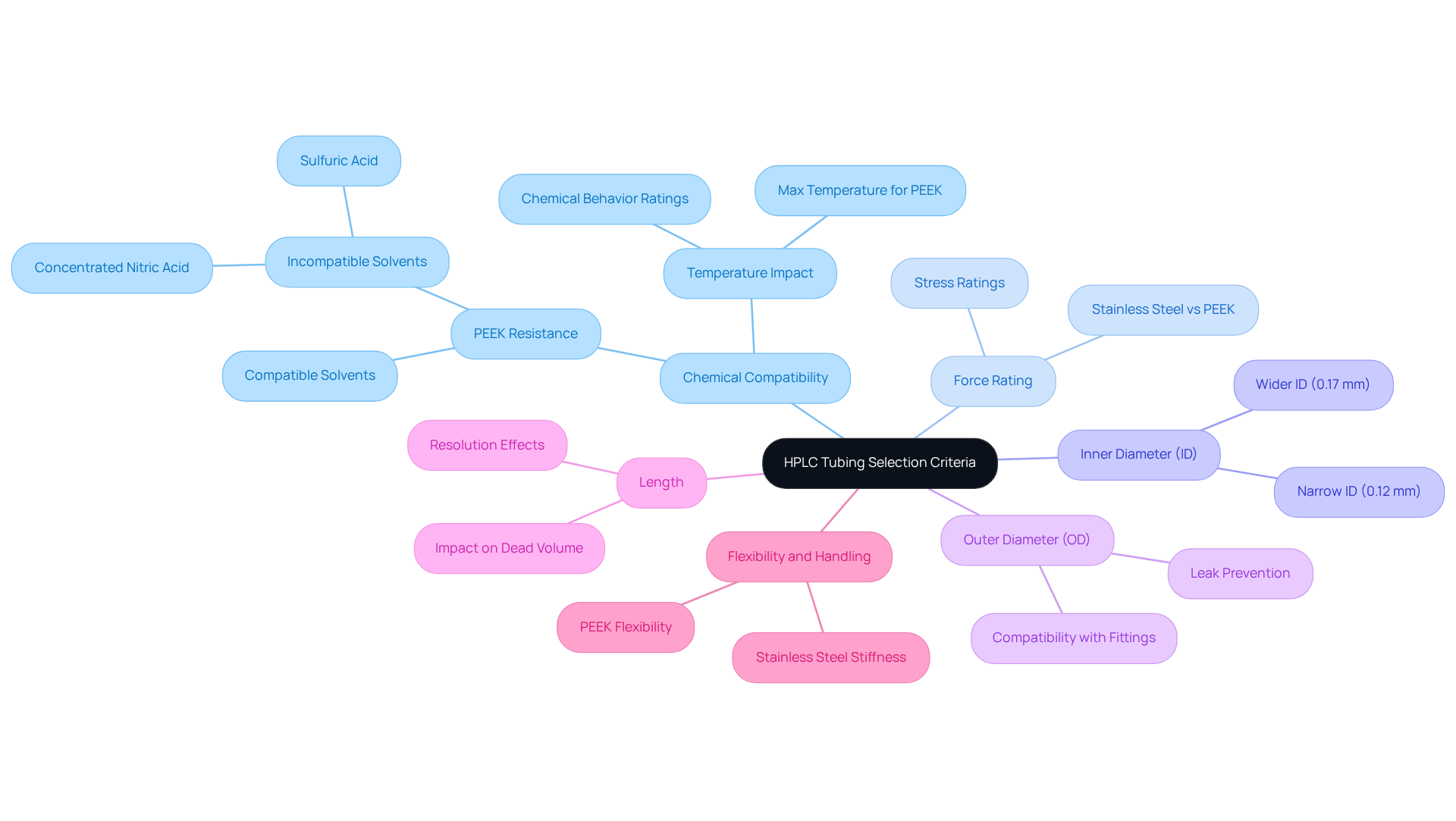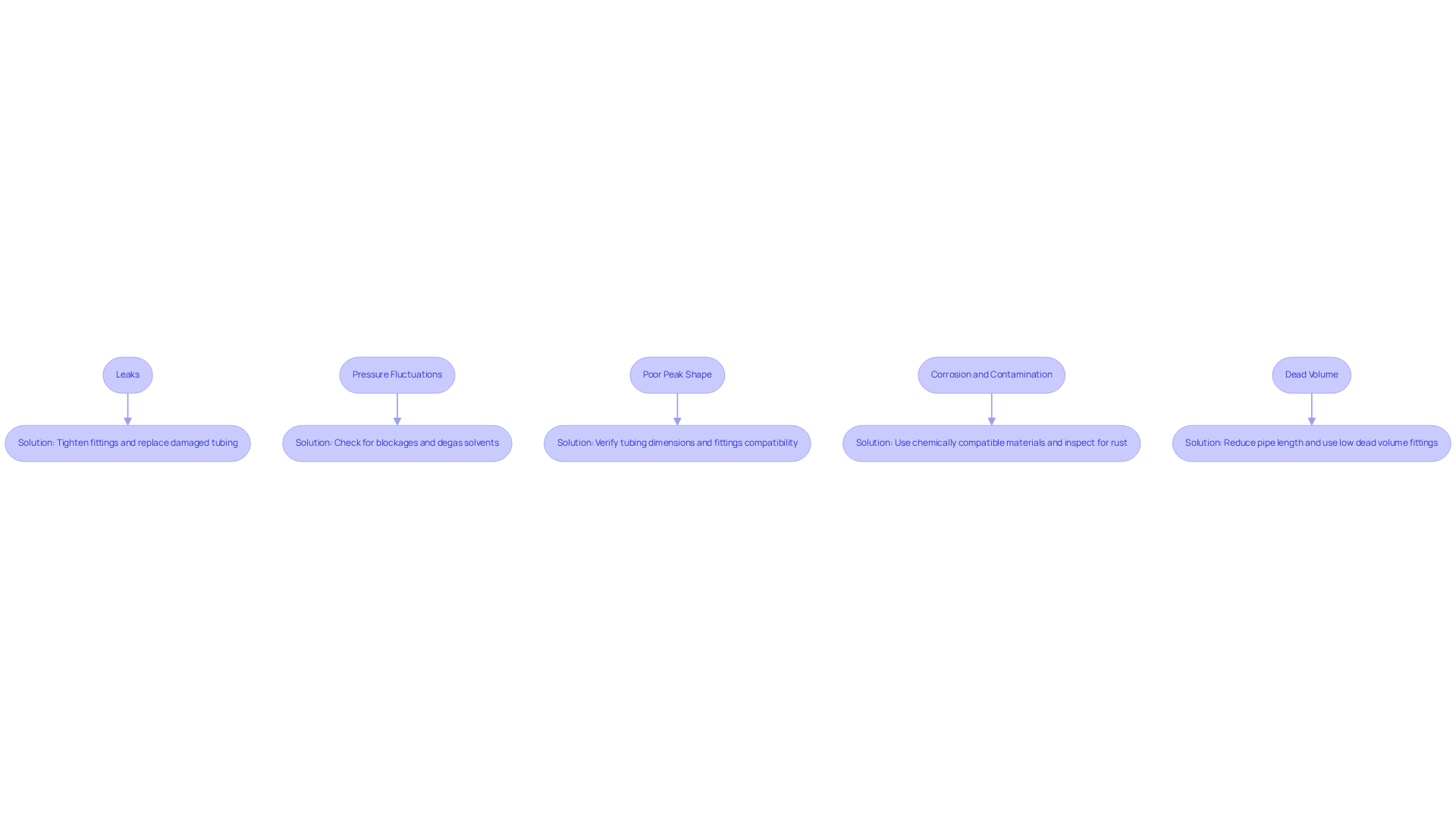Overview
This article delves into the essential selection criteria and prevalent challenges associated with HPLC tubing, underscoring the critical role of material selection, dimensions, and compatibility in achieving optimal liquid chromatography performance. It elaborates on how factors such as chemical compatibility, pressure ratings, and potential issues—including leaks and dead volume—directly influence the reliability and efficiency of HPLC systems. By providing practical solutions, this article aims to enhance operational integrity, ensuring that laboratory professionals can make informed decisions that bolster their analytical capabilities.
Introduction
Selecting the right HPLC tubing is crucial for maximizing the efficiency of high-performance liquid chromatography systems. With a variety of materials available, such as stainless steel and PEEK, each presents distinct advantages. Understanding the nuances of tubing specifications is vital for achieving reliable analytical results. However, the potential for leaks, pressure fluctuations, and other common issues poses a challenge.
How can one ensure optimal performance while navigating these complexities? This guide explores the key selection criteria and solutions for HPLC tubing, empowering readers to enhance their chromatography setups and troubleshoot effectively.
Understand HPLC Tubing Basics
HPLC tubing is a critical component in any liquid chromatography setup, as it serves as the conduit for solvents and samples. The choice of tubing material significantly impacts the efficiency and reliability of your analyses. Tubing is typically constructed from materials such as stainless steel or PEEK (Polyether Ether Ketone), each presenting distinct advantages that cater to various applications.
Material Types:
- Stainless Steel: Renowned for its durability and resistance to high pressures, stainless steel is frequently employed in HPLC applications. Its inert nature toward most solvents renders it suitable for a diverse array of analyses.
- PEEK: This plastic alternative is preferred for its flexibility and exceptional chemical resistance, particularly in scenarios involving aggressive solvents.
Dimensions:
- Outer Diameter (OD): The OD must align with the fittings and ports in your HPLC system to guarantee a secure connection.
- Inner Diameter (ID): The ID directly influences the flow rate and pressure within the setup. Selecting the appropriate ID is crucial for achieving optimal performance.
Pressure Ratings:
- Tubing must be rated for the pressures it will encounter in the system. For example, stainless steel pipes can endure greater pressures than PEEK pipes, a vital consideration for high-pressure applications.
Understanding these fundamentals empowers you to make informed decisions when selecting HPLC tubing for your high-performance liquid chromatography system. This knowledge not only enhances your operational efficiency but also ensures the integrity of your analytical results.

Evaluate Key Selection Criteria for HPLC Tubing
When selecting HPLC tubing, several key criteria must be considered to ensure optimal performance and reliability.
-
Chemical Compatibility is paramount; choosing tubing materials that align with the solvents and samples in use is essential. PEEK, for instance, exhibits outstanding resistance to a broad spectrum of solvents commonly utilized in high-performance liquid chromatography. However, it is susceptible to concentrated nitric and sulfuric acids, which can compromise its structure. Notably, PEEK can withstand 20-30% nitric acid for passivation, enhancing its applicability in specific scenarios.
-
Next, consider the Force Rating. The piping must endure the maximum force exerted by your HPLC system. Generally, stainless steel tubing offers a higher stress rating compared to PEEK, making it the preferred option for high-stress applications. It is also crucial to take into account the maximum recommended temperature for PEEK, which is 100°C, as this directly impacts its pressure rating.
-
The Inner Diameter (ID) of the tubing should align with the specific requirements of your application. Narrower IDs, such as 0.12 mm, are typically employed for high-efficiency columns, while wider IDs, like 0.17 mm, may be more suitable for standard applications.
-
Equally important is the Outer Diameter (OD). Ensure that the OD is compatible with the fittings and ports of your HPLC setup, as an incompatible OD can lead to leaks and inefficiencies in the system.
-
Consider the Length of the tubing carefully. Longer lengths can introduce additional dead volume, potentially affecting the resolution of chromatographic results.
-
Lastly, evaluate Flexibility and Handling. Depending on your laboratory configuration, flexible hoses may be necessary for easier installation and routing. PEEK pipes are often favored for their flexibility, contrasting with the stiffness of stainless steel, making them simpler to handle in various arrangements.
By carefully assessing these criteria, you can select the most appropriate HPLC tubing for your high-performance liquid chromatography setup, ensuring both efficiency and dependability in your analytical procedures.

Identify Common Issues and Solutions in HPLC Tubing
Common problems with HPLC lines can significantly impact system performance. Understanding these frequent challenges and their solutions is crucial for maintaining operational integrity.
- Leaks are a common issue in HPLC tubing, typically arising at fittings due to improper seating or damaged tubing. To address this, ensure that fittings are tightened correctly and examine hoses for wear or damage. Ongoing leaks may necessitate the substitution of pipes or fittings. It's important to note that leaks often lead to reduced force, which can stem from compromised pipes, fittings, or pump seals, or extremely low flow rates.
- Pressure fluctuations can also disrupt system functionality. These inconsistencies often result from blockages or air bubbles within the system. Regularly checking for blockages in the pipes and securing all connections is essential. Additionally, degassing solvents before use can eliminate air bubbles. As emphasized by Ted Palashis, highly sensitive lab instruments require appropriate and effective servicing and maintenance.
- Another challenge is poor peak shape, which can arise from improper dimensions of HPLC tubing or incompatible fittings. Verifying that the inner diameter (ID) and outer diameter (OD) of the HPLC tubing align with your application is vital. Ensuring fittings are compatible and properly seated can mitigate this issue.
- Corrosion and contamination present significant risks as well. Certain solvents can corrode tubing materials, leading to sample contamination. To combat this, utilize piping materials that are chemically compatible with your solvents and frequently inspect pipes for signs of rust. For example, Dursan® coating is twice as wear-resistant as 316 stainless steel and exhibits a corrosion rate improvement of over 170 times compared to uncoated stainless steel in HPLC applications.
- Lastly, dead volume can degrade resolution in chromatographic results. To minimize this, reduce pipe length and use fittings designed to decrease dead volume. Ensuring the ID of the HPLC tubing closely aligns with the measurements of the components is crucial. Reducing dead volume is essential for maintaining optimal chromatographic performance.
By recognizing these common issues and implementing the recommended solutions, you can significantly enhance the integrity and performance of your HPLC system.

Conclusion
Selecting the appropriate HPLC tubing is essential for optimizing the performance of high-performance liquid chromatography systems. The right choice not only enhances the reliability of analyses but also safeguards the integrity of results. Understanding the various materials, dimensions, and pressure ratings available empowers users to make informed decisions that align with their specific applications.
Key considerations include:
- The chemical compatibility of the tubing material with solvents
- The appropriate inner and outer diameters for effective flow rates
- The tubing's ability to withstand the pressures encountered in the system
Addressing common issues such as leaks, pressure fluctuations, and dead volume is crucial for maintaining operational integrity. Implementing the suggested solutions can significantly improve the efficiency and longevity of HPLC setups.
Ultimately, the importance of HPLC tubing extends beyond mere functionality; it is a cornerstone of successful chromatography. By prioritizing proper selection and maintenance of HPLC tubing, researchers and technicians can ensure optimal analytical performance, leading to accurate and reliable results. Embracing these best practices will not only enhance laboratory efficiency but also contribute to the advancement of scientific discovery.




